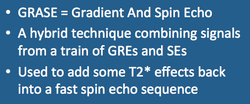 GRASE brain image accentuating low
GRASE brain image accentuating lowsignal in the basal ganglia due to
iron accumulation in PKAN syndrome
The acronym GRASE stands for “Gradient And Spin Echo”. It is a hybrid technique that generates and records a series of alternately acquired gradient echoes and spin echoes from a train of RF-pulses. In its original implementation, a 90°-RF pulse was followed by series of eight 180°-refocusing pulses, generating eight spin echoes. Centered about (and overlapping) each spin echo, three gradient echoes were produced by rapidly switching the readout gradient polarity. The final data set consisted of 24 separate MR signals having properties intermediate between spin-echo and gradient echo contrast.
The putative advantage of GRASE is that the gradient echo component would provide increased sensitivity for detecting calcifications and hemorrhages (often difficult to see on SE) while not having too much susceptibility artifact at normal anatomic interfaces. Additionally the energy deposition (Specific Absorption Rate, SAR) is lower than a comparable fast spin-echo sequence because there are fewer RF-pulses.
More modern implementations of this sequence allow adjustment of the relative numbers of GREs and SEs used. As such the relative degree of T2- vs T2*-weighting can be controlled.
In spite of its initial promise, GRASE has never really taken hold as a standard imaging protocol, although it is still offered as an option on most scanners and seems to enjoy some popularity at Philips sites. When used, it is most often an alternative to echo-planar and fast spin echo imaging for perfusion imaging, high-resolution, and 3D applications.
The putative advantage of GRASE is that the gradient echo component would provide increased sensitivity for detecting calcifications and hemorrhages (often difficult to see on SE) while not having too much susceptibility artifact at normal anatomic interfaces. Additionally the energy deposition (Specific Absorption Rate, SAR) is lower than a comparable fast spin-echo sequence because there are fewer RF-pulses.
More modern implementations of this sequence allow adjustment of the relative numbers of GREs and SEs used. As such the relative degree of T2- vs T2*-weighting can be controlled.
In spite of its initial promise, GRASE has never really taken hold as a standard imaging protocol, although it is still offered as an option on most scanners and seems to enjoy some popularity at Philips sites. When used, it is most often an alternative to echo-planar and fast spin echo imaging for perfusion imaging, high-resolution, and 3D applications.
Advanced Discussion (show/hide)»
No supplementary material yet. Check back soon!
References
Caruthers SD, Jara H, Melhem ER. MR imaging: some applications of GRASE. MedicaMundi 1998; 42(3):23-28.
Feinberg DA, Günther M. Cerebral blood flow imaging with 3D GRASE ASL sequence increases SNR and shortens acquisition time. MAGNETOM Flash (3/2009), pp 62-9.
Feinberg DA, Oshio K. GRASE (Gradient- and spin-echo) MR imaging: A new fast clinical imaging technique. Radiology 1991;181:597-602.
Caruthers SD, Jara H, Melhem ER. MR imaging: some applications of GRASE. MedicaMundi 1998; 42(3):23-28.
Feinberg DA, Günther M. Cerebral blood flow imaging with 3D GRASE ASL sequence increases SNR and shortens acquisition time. MAGNETOM Flash (3/2009), pp 62-9.
Feinberg DA, Oshio K. GRASE (Gradient- and spin-echo) MR imaging: A new fast clinical imaging technique. Radiology 1991;181:597-602.
Related Questions
How does a gradient echo differ from a spin echo?
How does a gradient echo differ from a spin echo?
